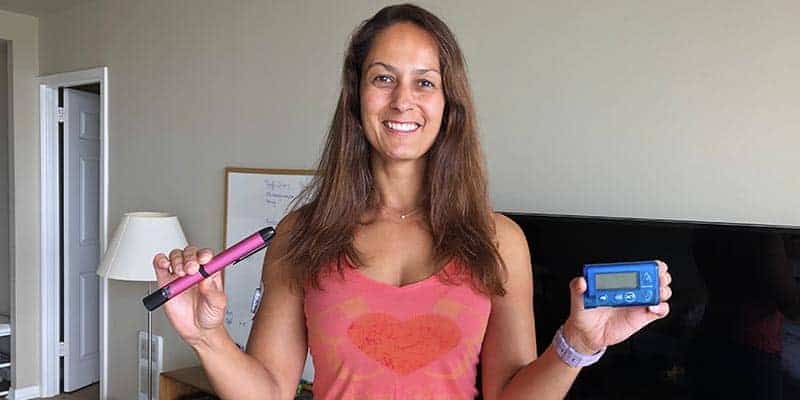I’ve lived with sort 1 diabetes since 1997, and I’ve been managing my diabetes with insulin injections (a number of every day injections – MDI) since day one. I briefly tried an insulin pump, and it was not for me, so I’m again to being completely happy and thriving doing MDI.
On this put up, I’ll stroll you thru my journey and why I select to make use of insulin pens over an insulin pump.
My aim with this text is to not sway you both manner, however to inform you my expertise and to provide the rundown of the professionals and the cons of insulin pumps and insulin pens respectively.
With the precise data, we are able to make knowledgeable decisions, and will probably be as much as you to decide on what appears best for you. There’s no one-size-fits-all with something on the subject of diabetes.
My system journey
After I was identified with sort 1 diabetes in 1997, I used to be handed a blood glucose meter and a prescription for prefilled insulin pens. Prefilled signifies that the insulin was already within the pens, all I needed to do was screw on the needle and draw up the variety of models I needed to dose. When empty, I simply tossed the pens within the trash.
As with anybody on MDI, I used to be prescribed short-acting insulin to cowl meals (bolus) and long-acting insulin to behave as background insulin (basal).
I don’t bear in mind precisely what sort of insulin I used to be prescribed however it required me to eat sure instances — it was in all probability NPH insulin. This basal insulin had a bit ball within the combination (like some bottles of nail polish do), and I needed to gently transfer the ball via the liquid to combine it earlier than use. Not precisely optimum, however it labored.
As newer insulins got here to the market, I switched to utilizing Levemir as my basal insulin and Humalog as my rapid-acting insulin, overlaying meals and corrections for highs.
The one factor that has modified for me since is switching from a prefilled Humalog pen to a sturdy pen, after which from a standard sturdy pen to a sturdy Smartpen. A sturdy pen merely signifies that the pen is reused and solely the insulin cartridge is tossed when empty.
The upside of a sturdy pen is that it may give ½ models of insulin (the prefilled used to solely be capable to do 1-unit increments). The upside of a Smartpen (I take advantage of an InPen) is that it helps maintain monitor of my energetic insulin on board (IOB), helps me in calculating my doses, jogs my memory once I must take my basal insulin, and mechanically information (via Bluetooth to my cellphone) all of the injections I take.
I’ve additionally added a steady glucose monitor (CGM) to my diabetes toolbox, and that has been an actual sport changer.
After I tried rocking a pump and why it didn’t work for me
In December 2017, 20 years into my life with diabetes, I made a decision to attempt an insulin pump. I needed the very best care, so I made a decision to attempt Looping. Looping is a DIY (Do It Your self) model of the substitute pancreas expertise.
A regular insulin pump will mechanically (based mostly on what it’s programmed to do) ship small quantities of rapid-acting insulin, similar to Novolog, Humalog, or Apidra, 24/7. Some use the newer insulin, Fiasp (one other fast-acting insulin) of their pump, nevertheless, Fiasp shouldn’t be FDA-approved to be used in insulin pumps in the USA.
You continue to must immediate the pump to provide you a bolus for meals or correction, however the background insulin is programmed and computerized.
With Looping (the DIY system) and the most recent Medtronic 670G system, the pump takes it one step additional by adjusting your basal insulin doses based mostly in your CGM readings.
If the system thinks your blood sugars will go too low, it would droop administering insulin till it determines that your blood sugar is at a secure and steady stage. If it thinks your blood sugar is rising, it will provide you with extra insulin.
That is sensible, and I’m such an enormous fan of the expertise, however there’s a downside. And that downside, and finally why an insulin pump didn’t work for me, is that the pumps are pumping rapid-acting insulin 24/7.
The drawbacks of rapid-acting insulin
Fast-acting insulins similar to Novolog, Humalog or Apidra take 15 to twenty minutes to achieve the bloodstream as soon as injected. It doesn’t peak till 1 to three hours after it’s injected, and it’ll keep within the physique for 3 to five hours whole.
The brand new child on the block, Fiasp, hits the bloodstream and peaks a couple of minutes sooner, however much like the opposite rapid-acting insulins, it stays energetic within the physique for 4 to five hours.
The chance of DKA
So, when you’re on a pump, you’ll want rapid-acting insulin to be circulating always to stop Diabetic ketoacidosis (DKA) from taking place (assuming you haven’t any insulin manufacturing by any means). Ought to the pump malfunction and cease delivering insulin, you’re at a heightened threat of going into DKA and ending up within the hospital.
Should you take your insulin by way of MDI, which suggests you all the time have background insulin on board, the chance of DKA is way decrease (this, after all, assumes you don’t neglect to take your every day background insulin dose.)
Low blood sugars & train
Since rapid-acting insulin lasts 3 to five hours, these utilizing an insulin pump must be very proactive in planning train or any motion in any respect. When exercising, going for a stroll, or doing on a regular basis duties like vacuuming, you’re susceptible to experiencing low blood sugar in case you have an excessive amount of rapid-acting insulin onboard. Since an insulin pump delivers rapid-acting insulin on a regular basis, you probably could have an excessive amount of insulin in your system for any sort of spontaneous motion the vast majority of the time.
Whether or not or not we use an insulin pump or MDI, all of us want to regulate our rapid-acting insulin if we wish to train or transfer round with out going low. Nevertheless, on MDI I solely have to fret about any bolus injections I’ve taken within the final 4 hours since my basal insulin hardly will get impacted by exercise.
When utilizing an insulin pump, I additionally needed to fear in regards to the insulin I’d acquired as basal for the final 4 hours. After all, that may be performed. However for me, all that basal adjusting was simply rather more of a problem in comparison with utilizing MDI to handle my insulin.
Pumps have advantages however not sufficient for me
As talked about, I used to be Looping so the pump would regulate my insulin when it estimated that I used to be about to have a low or excessive blood sugar. And it did, simply not successfully sufficient.
Since rapid-acting insulin lasts for 4 to five hours within the physique, there was no manner the Loop system might sustain with my exercise stage. Sure, it received smarter, however my days are hardly ever the identical and I’m a really energetic particular person. I used to be dropping low manner too regularly until I disconnected and micromanaged your complete program.
For a lot of, the system is life-changing. If we had entry to insulin that labored sooner and had a shorter length, I’d in all probability be utilizing an insulin pump.
The upside of basal (long-acting) insulin
Basal insulin doesn’t get impacted by exercise in the identical manner as rapid-acting insulin. That signifies that I solely have to consider adjusting my mealtime and correction boluses if I intend to train or simply be energetic. That signifies that if I determine to train proper off the bed, there is no such thing as a adjusting insulin. I simply go. Similar take care of afternoon train, so long as it’s greater than 4 hours after the final bolus.
Some tips say to scale back long-acting basal insulin on days when train is deliberate, and I typically try this. However all I regulate is my nighttime basal. My endo recommended splitting my basal right into a morning and a night dose, and it has labored wonders for me.
I maintain my daytime dose the identical (aside from days the place I’ll be sitting all day, like throughout an extended flight, then I’ll enhance it) and regulate my nighttime basal relying on my exercise stage. That signifies that I don’t must plan forward on the subject of my dose. I regulate it after the day is over.
Professionals and cons
In relation to selecting whether or not to handle your insulin with injections or an insulin pump, the selection could be very private — and the selection is yours! Each strategies have their execs and cons.
Professionals of utilizing an insulin pump
- Skill to set quite a lot of basal charges to match your private wants, with the choice to set small dosing increments
- Some built-in programs can regulate insulin based mostly on CGM readings
- Pumps maintain monitor of IOB, assist calculate doses, and have detailed reporting out there
Cons of utilizing an insulin pump
- Being disconnected for greater than 4 hours or pump failures can rapidly result in DKA
- The trendy insulins final too lengthy within the physique for the trendy pump programs to actually make sense
- Having to be connected to a tool 24/7
Professionals of a number of every day injections
- Lengthy-acting basal insulin hardly wants adjustment for exercise
- Not having one other system connected to you
- Much less threat of DKA on account of basal insulin and no system failure
Cons of a number of every day injections
- ½ unit is the smallest unit increment you’ll be able to dose
- Basal can solely be adjusted 1 to 2 instances every day (relying on whether or not you break up your dose) and the influence of that adjustment isn’t speedy
- Common pens (not Smartpens) would not have a bolus calculator or monitor IOB
What’s best for you: injections or a pump?
So perhaps you’re keen on your insulin pump or your insulin pens, or perhaps you’re prepared for a change. Perhaps you’re questioning if the grass is greener on the opposite facet and switching to a distinct insulin supply technique would enhance your diabetes administration and make life simpler.
For my part, you’ll be able to obtain wholesome blood sugar ranges with each strategies. What determines your success is how that technique of insulin supply suits together with your way of life, your character, and your willingness to take care of the cons of both technique.
For some, the chance of DKA with a pump doesn’t outweigh the stress of getting to take a minimum of 4 to six insulin injections day-after-day.
After I requested the Diabetes Sturdy group on Instagram in the event that they used an insulin pump or MDI, the responses got here again 50/50, which appears to point that my principle of there not being a “one-size-fits-all” is true.
I hope this put up helped offer you a extra nuanced image of the “Pump versus MDI” dialogue. And if nothing else, you bought to know me a bit higher.










